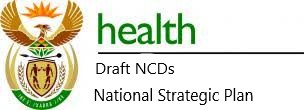
On 30 November, 2020 the current version of the NCDs NSP (draft 4 2020) was circulated to the NDoH Technical Committee for comment. We asked our stakeholder to comment again. However, within days the NDoH referred the draft Public Health England (PHE) for peer review. The methodology of the peer review is not known but members of the TC were asked to make input. WHO NCDs country representative, Dr Mwangi and I made comments. Click here to view.
We understand that the review is complete and await feedback and the consultant working on the NSP, contracted by the Better Health Programme, stated that it is likely in the next two weeks. As soon as we know, you will know!
An NCDs concept note, that is set to inform the expired national NCDs policy, is up for comment following a stakeholder consultation in April 2019.
Its purpose is to frame and inform South African NCDs policy for the next 5 years. It is the first policy developed in the Sustainable Development era (2015-2030).
Sustainable development goal (SDG) 3 = health. Target SDG3.t is to reduce early NCDs deaths by 1/3 by 2030
At the stakeholder meeting, NCDs civil society participation was limited at the stakeholder consultation due to 5 days notice. A Zoom connection was supplied but not audible. The link of an audio recording of the meeting is available here. Duration 2 hours.
WHO consultant Melvyn Freeman developed and presented concept noted. He the former Chief Director, NCDs at the South Africa National Department of Health.
Your comments are needed to inform the process.
 The South African elections are over, and it is back to business. It needs to be business as unusual in the case of NCDs prevention and management. Business as unusual? Einstein characterised insanity as doing the same thing over and over again and expecting different results.
The South African elections are over, and it is back to business. It needs to be business as unusual in the case of NCDs prevention and management. Business as unusual? Einstein characterised insanity as doing the same thing over and over again and expecting different results.
When advocates argue, politicians vote, and organizations campaign, they say they are trying to shape or respond to political will. Political will is the ghost in the machine of politics, the motive force that generates political action. Charney Research
Business unusual
NCDs policy is a case in point with the now expired South African NCDs strategic plan (2013-2017) failing dismally even to scratch the surface of the epidemic. Similar to much of SA health policy, it was purely window dressing, with implementation and budgets unmeasurable. For the last decade, communicable disease (like HIV and TB) is the only health concern of politicians. Jacob Zuma and his ilk came to power on that ticket with a policy emphasising “universal access” for people living with HIV. And so national health insurance (NHI) and its identical twin, HIV treatment access, were born. Politicians and deployed officials don’t differentiate between the two. When you add “health systems strengthening” and the “Ideal Clinic” to the HIV/NHI package, it equals the current broken and siloed healthcare system.
Policy consistency as art
Let us not pretend otherwise as we head for the 2nd State of the Nation Address in 2019 with a raft of fledgeling MPs for 6th Parliament. There is zero political will deal with NCDs. Oops, there are two exceptions: fiscal measures and cancers linked to HIV (cervix and breast at a stretch). In the health bit of the 2019 ANC election manifesto, NHI and HIV remain the only priority. The same goes for the 2019 health budget. Policy consistency as an art form, only Einstein says it is insanity
So, business as unusual for people living with NCDs means acknowledging that NCDs like diabetes, stroke, heart disease and chronic lung problems are the biggest killers in South Africa. It means giving NCDs an equivalent priority alongside HIV and TB and putting the missing money where its collective mouth is.
Political will is the missing ingredient in the SDG era. It is going to take more than cheap words and a dawn walk in the name of NCDs prevention.
Africa’s response to the epidemic of NCDs since the political declaration on NCDs in 2011 has been underwhelming.
74% of WHO AFRO countries do not have an operational national strategy/ plan that incorporates the major NCDs and their associated burden of disease.
NCDs is the fastest growing burden of disease in the Africa Region with the mortality rate increasing from 21% in 2010 to 30% in 2012.
Africa is in a precarious position, as most countries are under resourced and unprepared to deal with the fast growing NCDs epidemic. This will further lead to social and economic implications in the near and distant future.
The East African regional meeting co-hosted with the NCD Alliance sought to address this matter and gather all relevant stakeholders in place to move action and awareness forward.
With the low and often non-existent action on NCDs in African countries agendas the NCD Alliance, WHO AFRO and partners have co-signed an agreement to raise awareness and get action.
- Expedite the development and implementation of national NCD policies/strategic plans which are integrated across sectors.
- Increase and ensure adequate and sustainable budgetary allocations for NCDs in line with recommendations of the Addis Ababa Action Agenda.
- Strengthen health systems to respond to NCDs care and treatment including integrating NCDs care and treatment at primary health care settings
- Develop or, where necessary, adapt existing health information systems to collect comprehensive health data including NCDs to enable monitoring and appropriate planning.
The SA NCD Alliance (as PHANGO) is a partner in this initiative with 18 other organisations.
You can read the full document and press release here
In 2011 President Jacob Zuma and the South African government committed to NCDs prevention and control in line with global conventions. Since then many more commitments have been undertaken. As part of civil society’s watchdog role the SA NCD Alliance monitors how the government is doing. Today we release our report card covering the years from 2010 to March 2015. Click here to download the report.
March 2005 marks halfway through the national NCDs plan. There is still a lot to be done.
SA is doing fairly well at “population”
measures to prevent NCDs like legislation on smoking, salt reduction and food labeling. The relatively cost effective measures mean a bigger bang for each rand spent. We are all for that. However, there is much more to NCDs prevention and treatment (control.)
There are 6 main areas in the WHO’s NCDs Global Action Plan 2013-2020 are used to benchmark the governments progress. Out of over 25 indicators (see table below):
♦ Less than 1/4 were met:
♦ At least 3/25 critical items were not achieved; and
♦ the bulk (64%) were partially achieved or implemented.
This report was compiled by using official government reports, budgets and transparent interaction with stakeholders. It is a first of its kind in South Africa. Over 600 data sources were used. The Parliamentary Monitoring Group was the major source of government meetings.
None of this is a surprised to the National Department of Health because a year ago, armed with the preliminary findings, a NCDs Network delegation discussed our concerns with the Deputy Minister of Health, Dr Joe Phaahla. Sadly not much has changed since then.
Issues of concern include:
♦ A continuing and alarming trend to make policy and plans without any budgetary allocation;
♦ Minuscule budgetary allocation for NCDs within the Primary Health Care programme budget;
♦ Lack of provincial NCDs plans and budgets – the provinces provided the care but can’t do it without dedicated resources;
♦ Failure to include people living with NCDs in the roll out of “ideal clinics” (also known as Operation Phakisa and “integrated chronic care model”);
♦ Lack of patient-centredness including consultation with patients and those living with the illnesses (nothing for us, without us);
♦ Poor or non-existent monitoring and evaluation.
There is more but we would like you to take look. You be the judge, you use the services.
Below see the 6 areas of the WHO Global Action Plan. Green indicates achievement. Red no progress. Blue no evidence. All the rest partial progress/ implementation.
Download here



 The South African elections are over, and it is back to business. It needs to be business as unusual in the case of NCDs prevention and management. Business as unusual? Einstein characterised insanity as doing the same thing over and over again and expecting different results.
The South African elections are over, and it is back to business. It needs to be business as unusual in the case of NCDs prevention and management. Business as unusual? Einstein characterised insanity as doing the same thing over and over again and expecting different results.